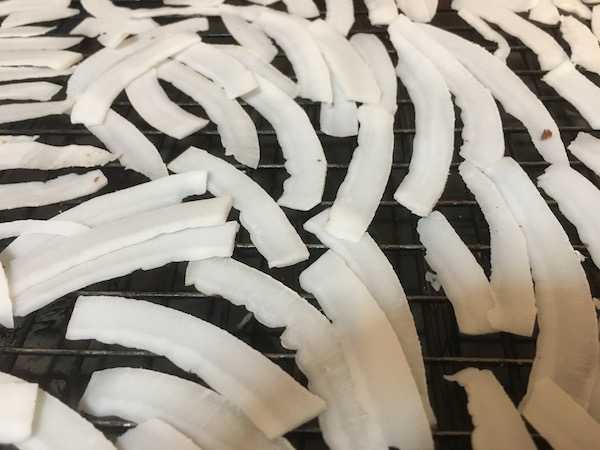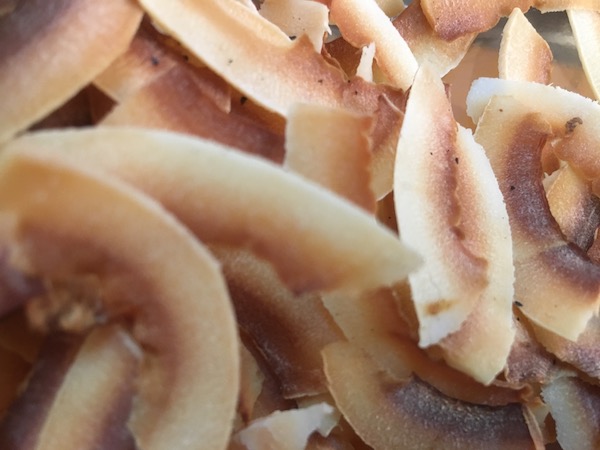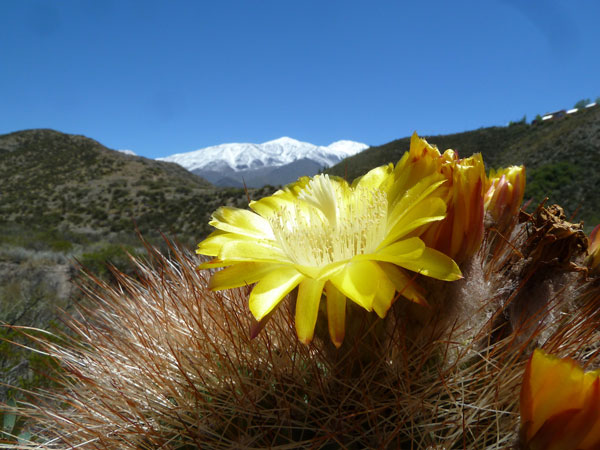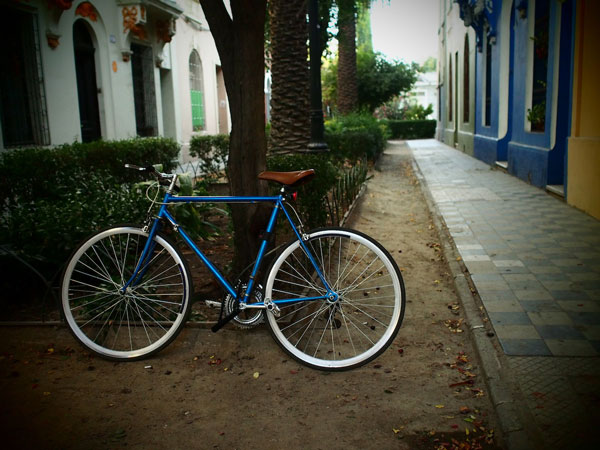What’s in a coconut?
Several things conspired to make this event happen. First, a friend recently was complaining that you can’t get fresh coconut in Santiago. Not true, I cried! And then set out to find them, and find them I did, in the Vega, in my case, in the Peruvian aisles. She said she’d bought one, but they it did not fit her special coco-needs, and I don’t remember why, but a seed was planted. (get it, coconuts are seeds!)
Then insert a trip to the United States whereupon my stomach went haywire. Well, truth is, its hay had been wiring (wire had been haying?) for some time, but while I was there, I was relegated to the rice aisle, and had many tasty, simple fish dinners prepared by friends and family far and near, who taught me the miracle of in-foil cooking, for which I am eternally grateful. Also, I am grateful for them understanding that I was not being difficult on purpose, but that eating super simply and avoiding 9 out of the 10 major food groups (I made that up) could keep me vertical and participatory. Go friends and family. Much love!
One of the things I picked up when I was in the states was the mono-ingredient “coconut chips.” I have always found the branding of single-ingredient goods to be really strange. Is there special ownership of corn kernels or dried apricots, or even coconut? But these coconut chips, they were good. And in truth, they had sea salt on them. I enjoyed them once I got back to Chile, and then lamented not having more.
But then I thought back to the great pomegranate syrup/molasses making experiment, and thought, but why can’t I have coconut chips here in Santiago? If all they are is coconuts (and salt) then surely I, a home chef of reasonable tenacity could also have coconut chips on this side of the equator.
And thus began the somewhat time-consuming, tiny bit messy, experiment that led to drinks (multiple), eats (multiple), a slightly warmer house, and a giant bag full of coconut goodness.
First, you must select the coconut. I did this by selecting a coconut. Really. I shook it, I could hear there was liquid and air inside, and I thusly purchased. I also watched a video on how to open a coconut, because though I’ve done it before, I remember some swearing. Turns out, you hold it in your hand, tap it with a hammer along the equator (not the longitude), and eventually it cracks. At which point I drained out the coconut water (drink 1), of which there was plenty. You can allegedly poke out the eyes of the coconut and drain it through there, but my coconut either had too much husk or no eyes, so I used this other method to both crack, and juice. Some husk got into the water. I strained it out.
Then there was the additional hammer tapping to break it into reasonable-sized pieces, following the prying of the flesh out with a butter knife, which was time-consuming, but otherwise uneventful. Then I peeled off the brown outer bit of the coconut with a carrot peeler, and finally, carrot-peeled slivers of coconut, which I placed on a cooling rack in the oven on low for about 45 minutes (drying on paper towels or over night would reduce the drying time. The store-bought ones are made in a dehydrator, I believe, and not quite as toasted, but single-use kitchen appliances are the devil, and am I really going to make my own tofu jerky in the future (spoiler, I suspect a soy intolerance, so no, I most certainly am not)?
And the results were fantastic, if somewhat long to process.
So at this point, I had the coconut water, which you can buy at great expense from your local fancy food place. In my case, I’d buy it in a tetrapak and I think it costs about $4.00. Then there were the coconut chips, which I am not sure you can get in Chile, and if you can, I suspect they’d cost about $5.00 for the same bag I bought in the US for about $3.00, and in this case I got about 5 times as much product for 1400 CLP, which is about $2.10 at the moment.
After doing the peeling of the coconut into shreds, I had leftovers that were too small or fussy to keep working with, maybe 1/3 to 1/2 a cup. These I put in a food processor with water, whirred a bit, squeezed it through a nut milk bag, and got about a cup of coconut milk out of it. This is similar to how I make almond milk, so a no-brainer. I also got about 4-5 tablespoons of coconut pulp, which I plan to mix into pathiri dough. Pathiri are a Kerala-style chapati (or like a Mexican tortilla) made out of rice flour, and traditionally brushed with coconut milk. They’re super easy and fast and gluten free, and it’s a hot-water dough, which is nice to knead in winter.
The only thing I didn’t find a use for was the coconut shell. I’m a bit inexpert, so it’s not like I could use a half as a bowl, because there were no halves left. I am so happy to have the luxury of time to putter in the kitchen. Also, for someone like me, who loves food and kitchen hacks and creativity, there was no better way for me to get back to normalcy after a long trip away, and my newly-acquired but hopefully short-lived food pariah status than getting into my kitchen and getting my hands, um, a bit greasy. But I have dry skin, so that’s just fine with me.
Hope you enjoyed the multiple uses of coconut comeback. I know I did.











